| Home |
| Acknowledgments |
| Conventions |
| Glossary |
| Maps |
| References |
| Links |
| Articles |
| Thumbnails |
| Species
list |
| Family |
| Next
species |
Additional Photos
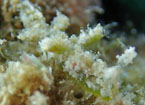
side, detail

top
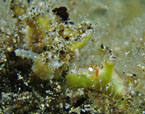
pair

light
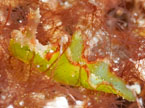
brown margins
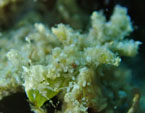
feeding?

Elysia sp. #13
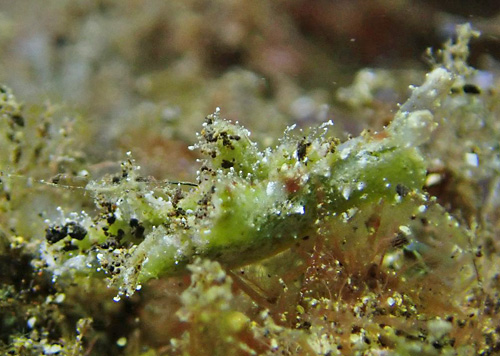
| Maximum size: about 10 mm. Identification: This species is greenish with variably developed, opaque-white patches. The parapodia have two narrow chimneys. Papillae are variably developed but are longer on the margins of the parapodia. The parapodia margins are sometimes frosted with violet-gray and there are red-brown patches located on the sides of the parapodia in front of the anterior chimneys. Occasionally, the red-brown pigment may extend to the margins of the parapodia. There is a violet patch on the top of the head and, sometimes, an opaque-white patch behind the head on the mid-line. In some animals, there may be a red-brown patch in front of the violet one. The rhinophores are translucent-gray, variably frosted with white and the eye spots are very close to their bases. Natural history: Elysia sp. #13 is known from seven animals found at moderately exposed to exposed sites at about 5-6 m (15-20 ft). All but two were found on sand-saturated algal turf containing multiple species of red and green, filamentous algae. (Note 1) (Note 2) Distribution: Big Island and Oahu: may be known from the Marshall Islands and western Pacific. Taxonomic notes: It was first recorded in Hawaii from Point Panic, Oahu by Roney Rodrigues and Damaris Torres-Pulliza on Jan. 30, 2021. It shows some similarity to Elysia tomentosa but differs from that species in its coloration, small size, narrow chimneys and probable food. It may be the same as "Elysia sp. #18" in Gosliner, et. al. (2018). (Note 3) Photo: Roney Rodrigues: side; about 10 mm: Point Panic, Oahu; May 23, 2022. Observations and comments: Note 1: Presumably, it feeds on one or more species of turf algae. Trowbridge, et. al. (2010) reports small Elysia spp feeding on filamentous red algae. So, this species may also feed on red algae. The one the animal in this photo appears to be eating looks like a common filamentous red (Ceramium sp.?) present in the algal turf. If it does feed on filamentous reds, maybe it also eats green algae since its greenish color suggests retention of green chloroplasts...? Note 2: All five of the animals found on sand-saturated algal turf had extensive sand on their surfaces. This may provide camouflage (encouraged by sticky mucus?) or may be coincidental. Note 3: The animal with brown margins on its parapodia is very close to the illustration from the western Pacific in Gosliner, et. al. (2018). |
| Thumbnails |
Species
list |
Family | Next species | Top |